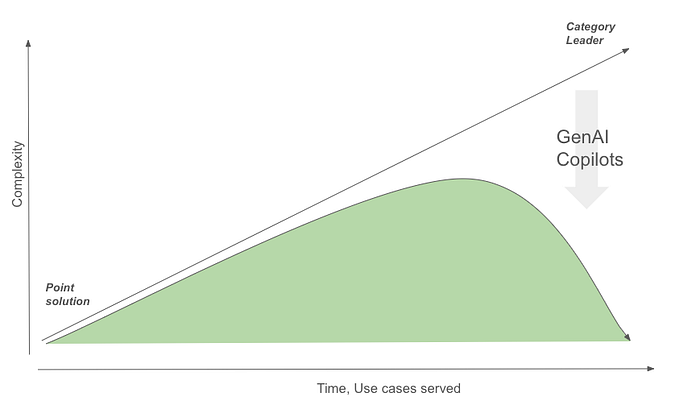This content originally appeared on HackerNoon and was authored by Hardik
Over the last decade, most SAAS market leaders that started as point solutions solving a narrow use case have expanded to multiple use cases and personas to serve, growing feature sets drastically. This has enabled them to expand their TAM and sell more licenses. But it has come at the cost of increasing product complexity.
\ Often, making the product relevant to expert users but complicated for users who only want to get specific jobs done from the product.
Salesforce user UI — As the product serves multiple use cases and personas in an enterprise, user journey, and navigation are complex and often well suited only to the expert user.
AI Co-Pilots to Increase User Efficiency
Users expect LLM-powered co-pilots to be more than just improved help chatbots powered through a RAG. Copilots can be extremely effective in abstracting out the complexities and breadth of any SAAS, giving users a shortcut to outcomes in your product.

Having worked and observed multiple SAAS teams figure out their co-pilot strategy, I analyzed three must-have use cases that SAAS copilot teams must focus on.
Use Case 1: Enhanced Help -> Support That Actually… Supports
Users today expect specific answers rather than sifting through endless pages of documentation. A copilot powered by Retrieval-Augmented Generation (RAG) on top of the existing knowledge base and community articles can elevate the support experience.
\ Your copilot can intelligently parse through your knowledge base, understanding the context of the user’s query and retrieving the most pertinent information. However, the secret sauce to building an effective support experience is beyond just improving RAG accuracy and more on:
\
Improving the breadth and quality of data sources by investing in community-generated content.
\
Providing customers an easy escalation path to human experts in experts.
Use Case 2: From Data Overload to Just Tell Me -> Actionable Insights
Data dashboards have been the key must-have feature set for all SAAS tools, but the dashboards deluge in SAAS can be overwhelming. Each user persona for SAAS has distinct insights needs — perhaps they need a specific view or a specific data point but generic dashboards create upfront friction for such users.
\ Imagine a scenario where, instead of staring at charts and graphs, trying to decipher trends, your users are greeted by a copilot that proactively highlights key insights or answers the data questions and presents the right graph. The LLMs not only share the data but also explain the insight building on top of the data.
\ “Your customer acquisition cost has decreased by 15% this quarter, primarily due to the success of your recent email campaign. Consider allocating more resources to similar initiatives.” A great example of this is TurboTax using LLMs to explain to users their deduction and tax amounts.
\ By transforming data into actionable insights, the copilot becomes an indispensable strategic partner. It doesn’t just present what happened; it explains why it happened and suggests what should happen next.
Use Case 3: Task Automation: From Complexity to Simplicity
Users value platforms that can reduce their cognitive load and automate complex tasks. Enter the realm of LLM (Large Language Model) agents within your copilot — AI entities capable of understanding, planning, and executing multi-step processes on behalf of the user.
\ Consider the often daunting task of setting up a new account with all the necessary configurations. Instead of navigating through multiple menus and options, users can simply instruct the copilot:
\
“Set up a new account for our marketing team XX with standard permissions.”
\ The copilot, leveraging agents, breaks down this request into agents and tools, executes them in the correct sequence, and reports back with a summary of actions taken. This not only saves time but also minimizes the risk of configuration errors.
\ However, there have been 2 challenges with the current agentic AI setups.
\ A. They only orchestrate well for a narrow set of actions and…
\ B. They fail often due to hallucinations compounding at each step of the agentic workflow. Thus, it becomes critical to narrow implementation to the most recurring tasks and linear tasks and solve them well. Ramp experimented with a good example of this.
\
Ramp tour guide — an AI Agent that can show you how to do anything on Ramp. It overcomes hallucination and error problem by keeping user in loop and assisting them through the workflow
\ As the capabilities of AI advance, delegating narrow tasks will shift to delegating entire workflows to AI. In the future, users could run these tasks without even logging into your SAAS product, all through a chat interface or as simple as just sending an email.
Conclusion: The Copilot Imperative
Integrating a copilot into your SaaS offering is essential for meeting and exceeding modern user expectations. From providing enhanced support to delivering intelligent insights and automating complex tasks, a well-designed copilot transforms the user experience.
\ It’s not just an AI assistant; it’s a partner that empowers your users, making them more efficient, informed, and satisfied.
\ The question is no longer whether you need a copilot. The real question is: can you afford not to have one?
This content originally appeared on HackerNoon and was authored by Hardik
Hardik | Sciencx (2024-07-02T01:42:02+00:00) Copilots in Modern SaaS: How to Simplify User Journeys With AI. Retrieved from https://www.scien.cx/2024/07/02/copilots-in-modern-saas-how-to-simplify-user-journeys-with-ai/
Please log in to upload a file.
There are no updates yet.
Click the Upload button above to add an update.
